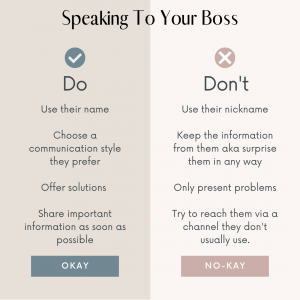How To Speak To Your Boss
When your boss schedules a meeting with you, does your heart immediately start pounding? Perhaps you begin to replay the last few weeks of work wondering what this meeting could possibly be about. A couple of questions are probably swirling through your mind.
- What do they want to talk about?
- Did I do something wrong?
These are natural things that may run through your mind.
Being able to confidently communicate with your boss is important for you and your career.
You want to remember a few things when you start to get nervous when thinking about having this next meeting with your boss:
- They’re human – Your boss is human. She or he is just like you. They have likes and dislikes. Remembering that they’re people too can help you ease some of that anxiety when you are meeting with them.
- Constructive Feedback – You may be walking into a meeting worrying that you will be receiving some harsh feedback and that may be hard to digest. But remember that constructive feedback can actually be a good thing. They are trying to help you become a better and more efficient worker. Look at it as a chance to improve yourself.
 Once you’re in this meeting with your boss, you want to be mindful of your communications as well. This means figuring out how you can communicate on their level too.
Once you’re in this meeting with your boss, you want to be mindful of your communications as well. This means figuring out how you can communicate on their level too.
A few questions to ask yourself before you speak with your boss:
- How does my boss like to communicate? Do they prefer context and lengthy explanations or do they prefer straightforward answers? Think about how they’ve communicated in meetings as that’ll give you a good gauge (see below for a longer explanation).
- Have I been forthright in my communications with them? In other words, is there a pattern of me leaving information out that is critical for my boss to know?
- How can I display confidence via my body language to show I am listening and engaged?
- Do I see my boss as a human or is there something I’m afraid of that may be in my own head?
Now let’s discuss the content of your communications when engaging with your supervisors, which we call having the Four Power Pillars.
The 4 Power Pillars
1. Communication Style
Identifying your boss’ communications style will reduce the amount of friction in your interaction today and moving forward. Some ways to identify what their preferences could be are by looking at the following communications channels:
Short emails – If your boss prefers short emails, be sure that you are keeping things concise and to the point. Don’t try to max out the word count.
Content emails – If your boss wants all of the information surrounding the reasons behind each point – be sure you are thorough. It may feel like a lot of content, but if it is what your boss requests it will be easier for you than responding to several follow-up emails.
Quick messages – Most companies use some sort of direct communication service. Slack, Trello, IM to name a few. If your boss likes to be updated with quick messages during the day – be sure that’s what channel you are using.
Phone Call – Yes, some people actually prefer a call! Hearing someone’s voice immediately lets you know the tone of the conversation and some people prefer this over digital communication. In fact, if there was some confusion, jumping on a call (if remote) is much better than trying to troubleshoot via written communications.
In-person – Does your boss like to come by your desk or have you come into their office for check-ins? Then do that! This may even help ease any of your anxiety with speaking with your boss because you do it so often.
Video Chat – Perhaps you are working remotely, and your boss likes to see you as you give updates. Again, this is a great way to practice speaking with your boss, so embrace it!
Once you are familiar with how your boss prefers to communicate you can set yourself up for success by communicating more often through that channel.
2. Offer Solutions
When speaking to your boss, you always want to make sure that you are offering solutions and not just presenting problems.
For example, let’s say you are working on a project. While working on this project you find that you are hitting a wall or aren’t sure what to do next. Instead of simply saying, hey I have a problem, consider taking a few steps back and come up with a few solution options. Being able to do that not only shows that you are being proactive but it also shows your critical thinking skills.
There are a few ways to offer solutions.
Explain the solution you’ve tried – When explaining the problem to your boss, it is important to show that you have tried certain solutions. Explain why you’ve tried them and they have or have not worked.
Give Clarity – When giving solution options, be clear about which direction you think will work best, and remember to always explain the WHY behind it.
Give Pros + Cons – When offering solutions to a problem be sure to give the pros and cons to each one. When you do this you again show that you are thinking proactively and are showcasing your critical thinking skills.
Offering solutions will help you be seen as leadership material.
This presence can help you move up in your career and will help you when you begin to manage others.
3. No Surprises
 Part of effectively communicating with your boss is making sure there are no surprises. In other words, you do not want your boss finding out something about you from someone else.
Part of effectively communicating with your boss is making sure there are no surprises. In other words, you do not want your boss finding out something about you from someone else.
For example, if you are working on a project and you are given information that your boss doesn’t know about yet, but that greatly impacts the project. Instead of simply forwarding an FYI or throwing it out there to them without any context – consider summing it up. Summing it up in a high-level sentence or two can really go a long way. Or better yet, putting it all in one email so they can refer to it and not inundate their inbox.
According to Forbes, if you want to manage up, you will never want to surprise your boss. Your boss can be extremely helpful for you in your career success.
However, if your boss feels like you are trying to undermine them, that can cause a lot of problems.
Truth is, there will be times when you are caught off guard, but the sooner you communicate any and all issues the better.
4. Use Their Name
Say their name when speaking with them! This may seem like a strange power pillar, but it works. However, if you are able to say your boss’s name when you are engaging with them, it shows your comfort level and your presence around them.
For example, if you are seeing your boss, you can say – “Hey Ken! Really good to see you.” or “That’s a really great idea, Ken, have you also thought about this?”
There’s something about saying someone’s name as you are engaging in conversation with them that not only shows that you’re comfortable, but that you’re confident.
If saying your boss’s name makes you nervous, there are a few ways you can practice.
Always say good morning – If possible, always say good morning to your boss using their name. You can even do this in an email, on a chat, or on a video call. Practicing this will allow you to be more comfortable with using their name.
Regularly ask about their weekend – This is another way to use their name. Hi, Ken, how was your weekend? Start by asking once a month and once you feel comfortable, increase to two times and more.
Say hello before a meeting – Most teams have a weekly meeting or perhaps a weekly check-in. Instead of simply saying hi, be intentional and say your boss’s name. When you say this, go in an upward tone as that’ll show your positive energy and alertness.
When you’re communicating with your boss, it certainly can be nerve-wracking. And you may even feel anxious about it.
Just remind yourself that they’re just like you and remembering the 4 power pillars, and how you approach communicating with them can not only make you feel more confident but more comfortable.
__
Whenever you’re ready, there are 3 ways we can help you:
- Discover your communications style so you know where to start. Over 4,000 people have found theirs here.
- Attend our monthly communication workshop to build communications confidence (new topics: public speaking, advocating for yourself, building credibility, etc) here.
- Get your brand in front of 43k+ people by sponsoring our newsletter or Soulcast Media | LIVE LinkedIn events [contact: hello@soulcastmedia.com]











